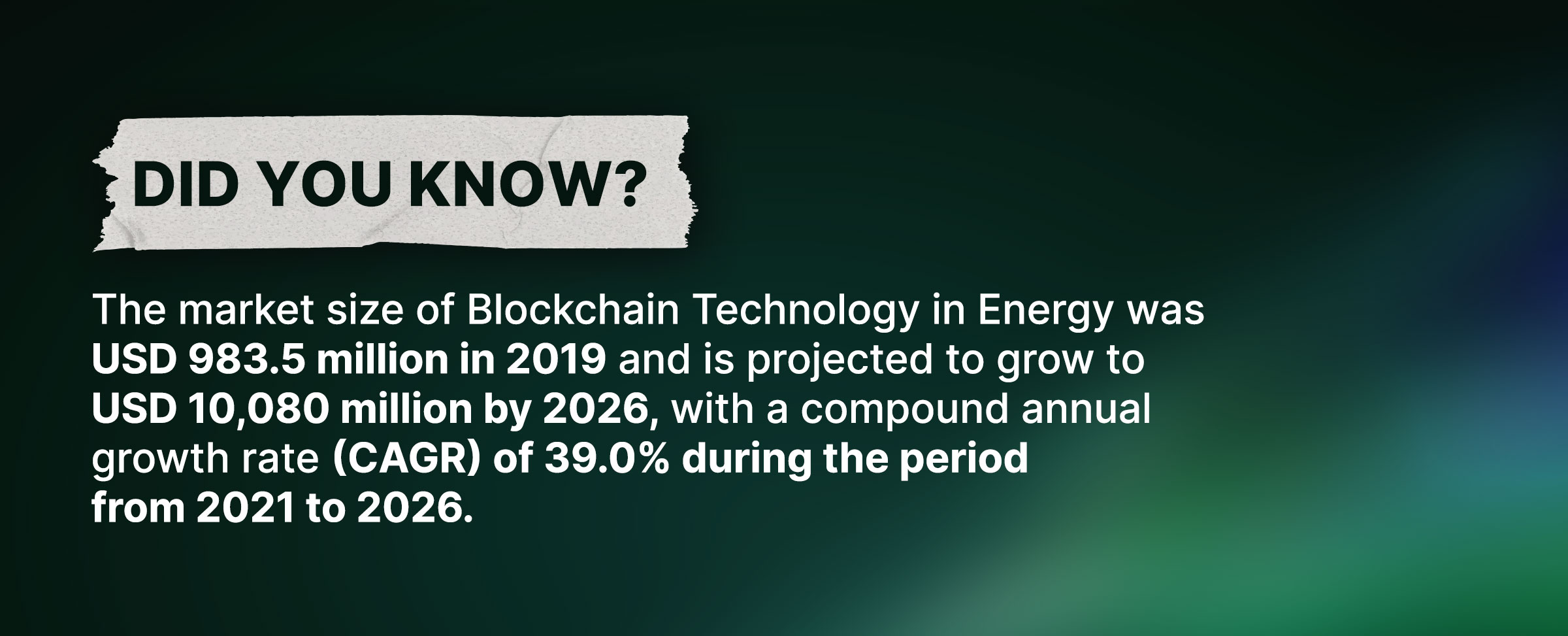SHARE THIS ARTICLE
Securely Storing and Transferring Carbon Credits in the Energy Industry Using Blockchain Technology

Carbon credits have become an increasingly popular tool for companies and organizations to offset their carbon emissions and contribute to the fight against climate change. However, the traditional methods of storing and transferring carbon credits have faced significant challenges such as fraud, double-counting, and a lack of transparency. As a result, trust in the carbon credit market has diminished, making it harder to promote sustainability initiatives.
Blockchain has the potential to transform the way carbon credits are stored and transferred in the energy industry. It can increase security, transparency, and efficiency, and promote greater participation in sustainability initiatives. With these benefits, Blockchain can help to build trust in the carbon credit market and support the transition towards a more sustainable future.

The Energy Web Foundation's Energy Attribute Certificates (EAC) Registry is an example of a blockchain application being used in the energy industry to track the ownership and transfer of renewable energy certificates. This Decentralized ledger technology ensures that renewable energy certificates are genuine, can only be owned by one entity at a time, and can be tracked throughout their lifecycle.
The Challenges of Storing and Transferring Carbon Credits
The traditional methods of storing and transferring carbon credits have faced several challenges that have hindered the growth of the carbon credit market. One of the main challenges is a fraud, where unscrupulous entities create fake carbon credits or double-count existing ones. This results in a loss of trust in the carbon credit market and undermines the effectiveness of carbon offset programs.
Another challenge is the lack of transparency and accountability in the carbon credit market. It can be challenging to track the ownership and transfer of carbon credits, making it difficult to ensure that they are genuine and are being used to offset carbon emissions effectively. This lack of transparency can also lead to the same credits being sold and resold, which leads to a loss of trust in the market.

Blockchain can address these challenges by providing a decentralized and immutable ledger that can securely track transactions and ownership of assets. By using decentralized ledger technology, carbon credits can be tracked from creation to retirement, preventing double-counting and ensuring the integrity of the system. This transparency and accountability can help to build trust in the carbon credit market and promote greater participation in sustainability initiatives.
Blockchain technology can also provide increased security and efficiency in the storage and transfer of carbon credits. As a decentralized system, it eliminates the need for intermediaries and reduces transaction costs. Additionally, it can enable smart contracts, which can automate the transfer of carbon credits when certain conditions are met. This can help to streamline the process of transferring carbon credits, making it faster and more efficient.

Overall, Blockchain Development Services providers can help revolutionize carbon credit markets by providing innovative solutions that utilize blockchain technology to create secure, transparent, and efficient platforms for tracking and verifying carbon credits. These solutions have the potential to expedite the shift towards a thriving future by optimizing processes, cutting down transaction costs, and fostering trust within the market.
Benefits of Using Blockchain for Carbon Credits in the Energy Sector
Using blockchain technology for carbon credits in the energy sector can provide several benefits, including:
-
Increased transparency: Blockchain provides a transparent and tamper-proof ledger of transactions, allowing for greater accountability and trust in the carbon credit market.
-
Enhanced security: The decentralized nature of blockchain makes it more secure than traditional centralized systems, reducing the risk of fraud and cyber-attacks.
-
Improved efficiency: By automating the verification and tracking process, blockchain can reduce the administrative burden and costs associated with traditional carbon credit systems.
-
Incentivizing sustainable practices: By enabling the secure tracking and verification of sustainable practices that reduce carbon emissions, blockchain can incentivize businesses and individuals to adopt more sustainable practices.
-
Standardization: Blockchain can provide a standardized approach to tracking and verifying carbon credits, allowing for greater interoperability and coordination across different markets and regions.
Blockchain for Sustainability: Real-World Applications in the Energy Industry
Blockchain is enabling the energy industry to improve sustainability and reduce carbon emissions, with real-world applications such as carbon credit markets, energy trading platforms, and decentralized renewable energy systems. There are already several examples of how Blockchain Industry Solutions are being used in the energy industry for carbon credits:

-
IBM's "Blockchain for Climate" initiative: This project aims to use blockchain technology to create a more transparent and secure carbon credit market. It involves working with major corporations and organizations to develop blockchain-based solutions for tracking and verifying carbon reduction and removal efforts.
-
Power Ledger: This blockchain-based platform allows users to trade renewable energy and carbon credits in a secure and transparent way, incentivizing the adoption of sustainable practices and supporting the transition to a more decentralized energy system.
-
LO3 Energy: This company uses blockchain technology to enable peer-to-peer energy trading and the secure tracking of renewable energy generation and consumption, ultimately supporting the transition to a more sustainable energy system.
-
Climate Coin: This cryptocurrency is designed to incentivize sustainable practices by rewarding individuals and organizations for reducing their carbon footprint. The cryptocurrency can be exchanged for carbon credits or used to fund renewable energy projects.
These examples demonstrate the potential of blockchain to transform the carbon credit market and support the transition to a more sustainable energy system.
1686558127561.jpg)
Conclusion
The future of blockchain in the energy sector is promising, with the potential to enable the transition to a more decentralized energy system, improve energy efficiency, reduce carbon emissions, and promote sustainable energy production and consumption. Blockchain-based platforms can also facilitate the development of smart cities, enabling the secure exchange of data between different energy systems to optimize efficiency and reduce waste.
As a leading provider of Blockchain Technology Solutions, Codezeros has the expertise to help businesses leverage this transformative technology to achieve their sustainability goals in the energy sector and beyond.
Post Author

Vivek is a passionate writer and technology enthusiast with expertise in blockchain development. As the lead writer for Codezeros, he aims to educate and inform readers about the potential of blockchain technology and simplify complex concepts to present them in an engaging manner for both technical and non-technical readers.



